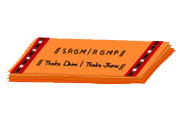Posted By: Administrator
Rāga: Rāgamālikā
Thāḷa: Miśhrachāpu
Composer: Vazhuvūr Ramiah Piḷḷai
Language: Thamizh(Tamil)
Meaning - Word by word & Note: ?
Meaning - Overall: Team Ambalam
Alignment, Diacriticals &
consequent spelling changes, Language & grammar editing, if any and
necessary, of existing meaning: Team Ambalam
Pallavi:
Véṇugānane Kōri Enmanam, Nāḍi Nirkaiyil Mōḍi Seivathu Nyāyama?
Sakhhi Nī Ivvéḷaiyil Mōḍi Seivadhu Nyāyama?
Charanam 1:
Antha Migunthan En Sontha Nāthan Pāthāra Vinthathukiṇai Kūriḍalāgumā?
Aravindha Malarum Īdākuma?
Charanam 2:
Bharatha Kalai Thani Parava Aruḷ Saitha
Paramanin Thiru Kumaranaithān Marugan Enum Thirumāl Thanai
Paravi Pugazhndhu Paṇinthu Maghiznthavar Thiruvaḍi Pugazh Pāḍi Ādi Paṇiyuvom
Meaning:
Pallavi:
Véṇugānane Kōri Enmanam, Nāḍi Nirkaiyil Mōḍi Seivathu Nyāyama?
Sakhi Nī Ivvéḷaiyil Mōḍi Seivadhu Nyāyama?
Sakhi - My friend
Nyāyama? - Is it fair?
Nī - you
Mōḍi Seivadhu - To be deceitful
Ivvéḷaiyil - At this time
Enmanam - My heart
Kōri - Desires/yearns
Véṇugānane - for krishna (one who creates music with his flute)
Nāḍi Nirkaiyil - with eager anticipation
O Friend, is it fair on your part to be deceitful at this time when
my heart desires for Kriṣhṇa with eager anticipation?
Charanam 1:
Antha Migunthan En Sontha Nāthan Pāthāra Vinthathukiṇai Kūriḍalāgumā?
Aravindha Malarum Īdākuma?
Kūriḍalāgumā? - Can one say?
Pāthāra Vinthatham - For anything other than lotus-like feet
En - my
Sontha - Own
Nāthan - Lord
Antha Migunthan - Who is beauty personified
Aravindha - Will even a lotus
Malarum - Flower
Īdākuma? - Be equal to him/his feet in beauty/softness?
Can anyone even say that the lotus flower equal the softness of the
(lotus-like) feet of my Lord who is beauty personified?
Charanam 2:
Bharatha Kalai Thani Parava Aruḷ Saitha
Paramanin Thiru Kumaranaithān Marugan Enum Thirumāl Thanai
Paravi Pugazhndhu Paṇinthu Maghiznthavar Thiruvaḍi Pugazh Pāḍi Ādi Paṇiyuvom
Pāḍi - let us sing
Ādi - And dance
Paṇiyuvom - And bow down in
prayer
Thiruvaḍi - At the sacred
feet
Maghiznthu - joyful exhilaration
Pugazhndhu - By adoring
Paravi - Praising
Paṇinthu - And praying
Thirumāl – Lord Vishnu
Enum - Who calls
Thiru Kumaranai - The divine Son
Paramanin - Of the great
lord
Aruḷ Saitha - Whose divine
blessings
Parava - Have resulted in the
spread
Bharatha Kalai - Of this dance
form
Than - His
Marugan - Nephew
Let us sing and dance; bow
down in prayer at the sacred feet ; with joyful exhilaration and adoration;
praising and praying to Lord Viṣhṇu ,
who is proud of his nephew Murugā, the son of that Lord who was instrumental in
spreading Bharathanātyam.(Śhiva)
Note:
[1] The term nephew of Vishnu/mal has been used to describe both Muruga
(for example, in the phrase mal maruga muruga shanmukha guha)and Ganapati (for
example, in the sloka - srikanto matulo yasya...)
[2] Obviously a convoluted way as any other to refer to the cosmic dancer,
Śhiva.
Anu pallavi: inai kuridal aguma?=is it possible at
all to speak of anyone equal to him? He is incomparable.
caranam: paravi and pugazhndu (praise) mean the same. Repetition for emphsis, i
suppose.
you can also read it as the son of one who was instrumental in spreading
bharata kalai and tan maruagan enum tirumal tanai=that vishnu who is proud to
own murugan as his nephew.












